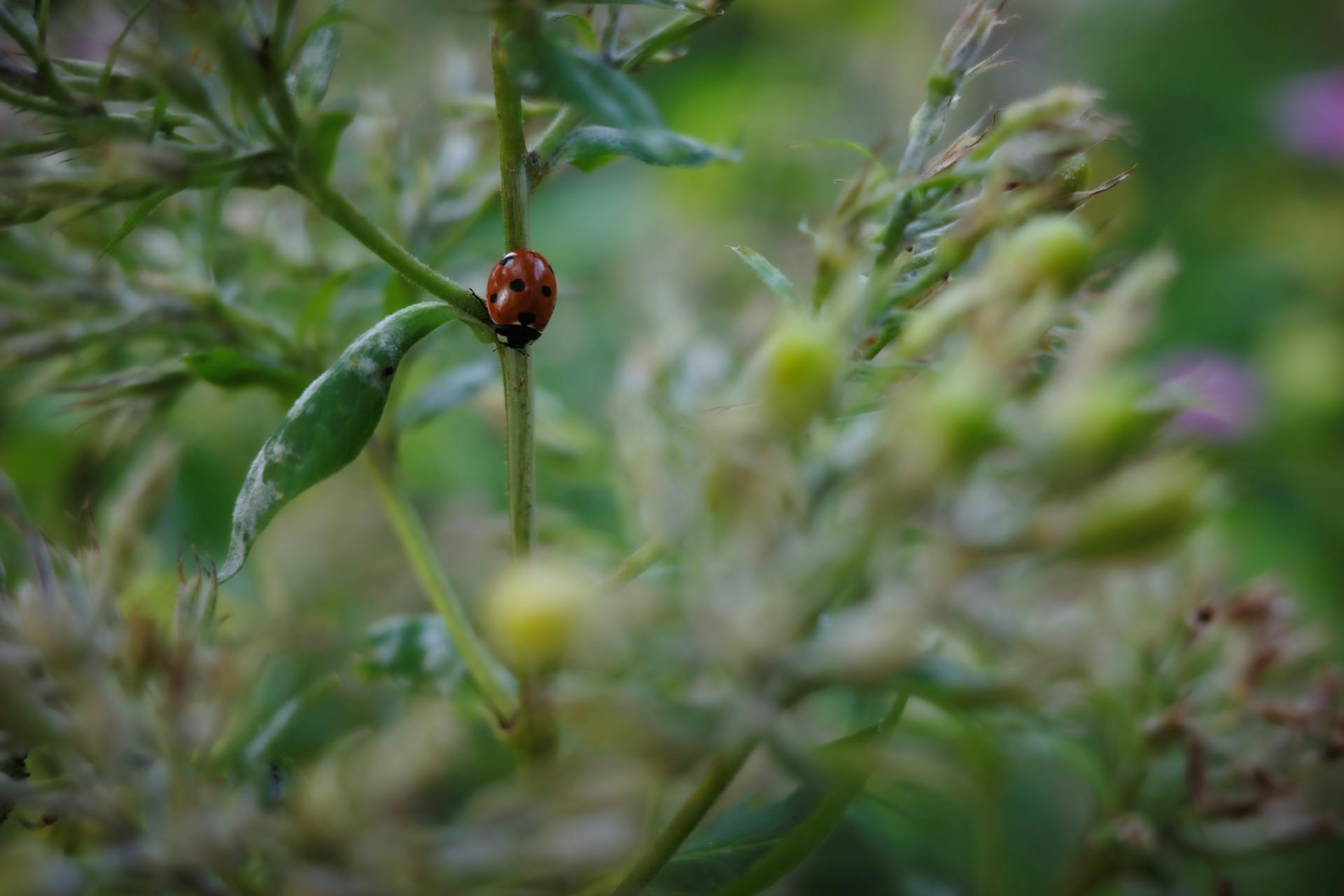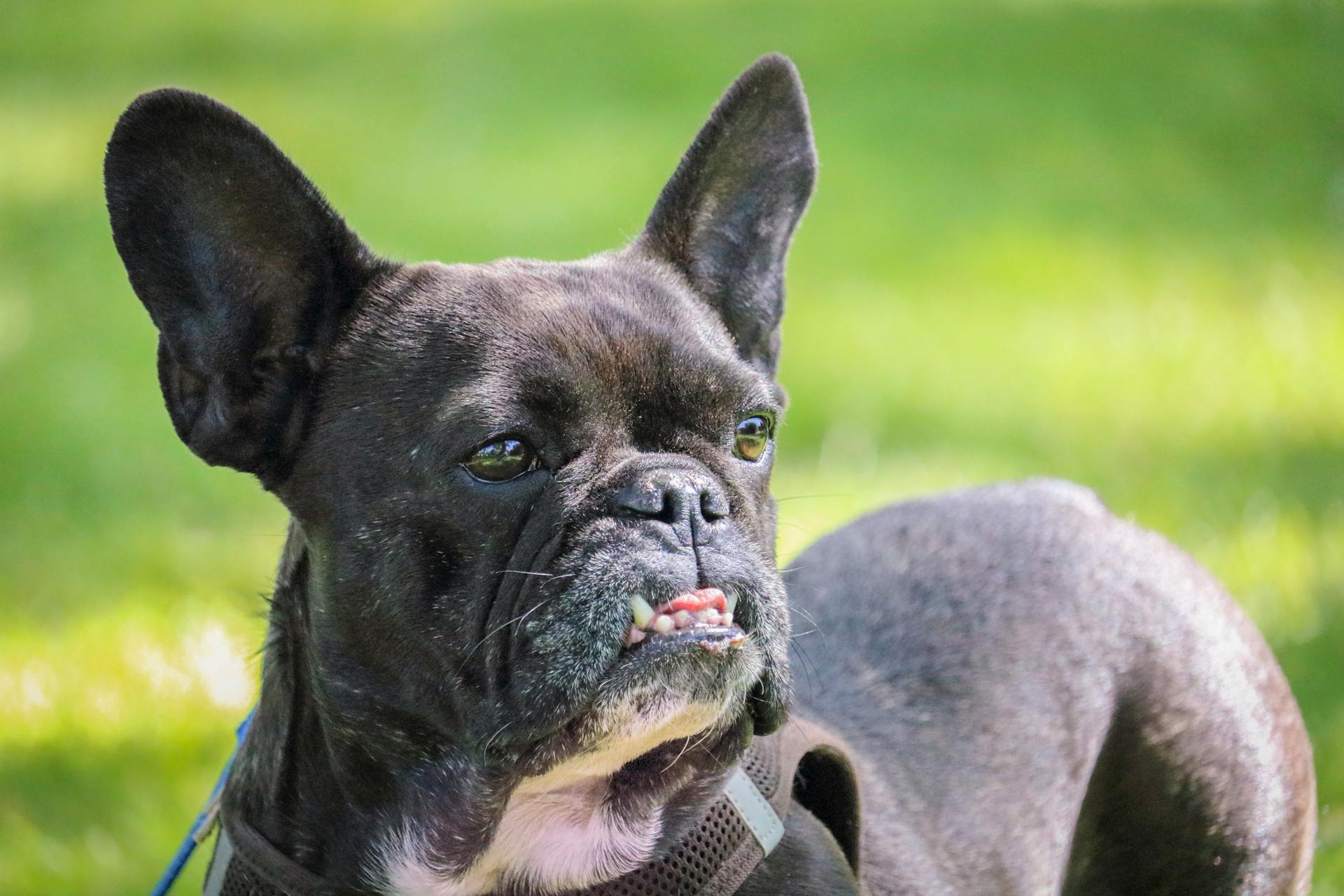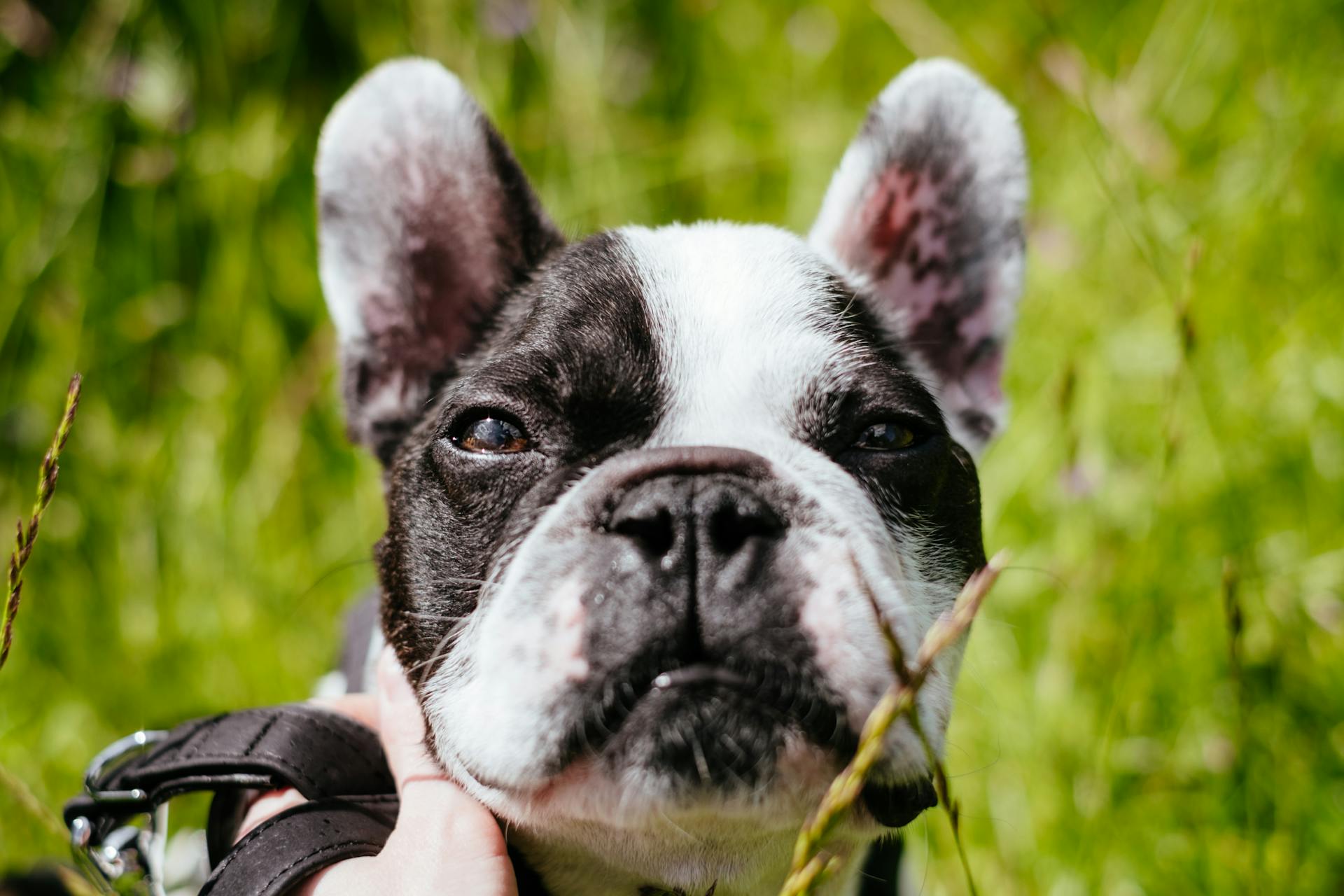
Spotted French Bulldogs are a beloved breed for many families due to their affectionate nature. They thrive on human interaction and make great companions.
Their adaptable size makes them perfect for city living, as they require minimal exercise. With a short, easy-to-maintain coat, they're a great choice for busy families.
Spotted French Bulldogs are known for their playful and gentle personalities, which make them an excellent choice for families with children. They're relatively low-maintenance pets that bring joy and love into any home.
Readers also liked: Spotted Dog Names
Breed Information
French bulldogs are a compact breed, standing between 11-13 inches tall and weighing up to 28 pounds.
Their large heads and wrinkled faces are a distinctive feature, along with their prominent eyes and flat noses.
Frenchies come in a variety of colors, including brindle, cream, fawn, black, and pied (spotted mixes of approved colors).
History
The French Bulldog breed has a rich and fascinating history that spans centuries. The breed originated in England in the 19th century as a miniature version of the English Bulldog.
In the mid-19th century, lace workers from Nottingham, England settled in Normandy, France, bringing their Toy Bulldogs with them. These dogs became incredibly popular in France, and a trade in imported small Bulldogs was established, with English breeders sending over Bulldogs that were considered too small or had faults such as erect ears.
By 1860, there were few Toy Bulldogs left in England due to their popularity in France. The small Bulldog type gradually became a recognized breed, known as the Bouledogue Francais.
The breed's popularity extended beyond France, with society ladies, artists, and writers in Paris and other cities falling in love with the French Bulldog's unique appearance and charming personality.
In the late 19th century, the French Bulldog was introduced to America, where it quickly gained popularity among the upper class. The breed was officially recognized by the American Kennel Club (AKC) in 1898.
Here are the original colors of the French Bulldog breed:
- Brindle
- Pied
- Cream
- Fawn
- Black
- Gray
Basic Facts
The French bulldog is a non-sporting dog, according to the AKC.
They're active dogs, but their extra-short noses put a damper on their athletic abilities.
French bulldogs are compact, standing between 11-13 inches tall.
Their smooth coats come in a range of colors, including brindle, cream, fawn, black, and pied.
Those enormous bat ears are one of their trademark features.
Their large head is home to an expressive, wrinkled face and prominent eyes.
French bulldogs typically top out at 28 pounds.
Physical Characteristics
French Bulldogs are known for their unique physical characteristics, and one of the most distinctive features is their flat face.
Their head should be square shaped and large, with ears that resemble bat ears.
A French Bulldog's weight is at maximum 28 pounds (13 kg), making them a relatively small breed.
Description
The French Bulldog is a muscular breed with a soft and loose coat that forms wrinkles. This unique coat texture is a key characteristic of the breed.
Their weight is limited to a maximum of 28 pounds, which is a relatively small size for a dog.
The head of a French Bulldog is square-shaped and large, with ears that resemble bat ears. This distinctive ear shape is a defining feature of the breed.
French Bulldogs have flat faces, which is a result of their brachycephalic skull structure. This means their eyes are positioned quite close together.
Dark, almost black eyes are the only color approved by the AKC Standard for French Bulldogs. Blue-eyed French Bulldogs are not recognized by the breed standard.
Their short-haired coat is fine and silky to the touch, requiring minimal grooming.
Common Colors
French Bulldogs are adorable animals, and their coat colors are a big part of their charm. The AKC, a regulatory body for French Bulldogs, recognizes 10 coat colorations or patterns.
Pied, fawn, and brindle are popular coat patterns and colors. There are no specific difficulties in getting a puppy with a light grey, darker brown, blue, or golden coat.
Frenchies come in a variety of colors, but the AKC only recognizes certain ones for competitions. If you're planning to show your Frenchie, make sure to check the recognized colors.
See More Examples
The French Bulldog's physical characteristics are truly unique and adorable. One of the most distinctive features of this breed is their short stature, with some adults reaching only 11 inches in height.
Their short coats come in a variety of colors, including brindle, fawn, and white. French Bulldogs are often referred to as "bat-eared" due to their distinctive ear shape.
Looking at pictures of French Bulldogs, you can see the variety of coat patterns and colors they come in. For example, French Bulldog Pictures 1 shows a dog with a striking brindle coat.
Some French Bulldogs have a more compact build, while others are slightly taller and leaner. French Bulldog Pictures 2 showcases a dog with a more athletic build.
Their short coats require minimal grooming, making them a great choice for busy owners. French Bulldog Pictures 3 features a dog with a beautiful fawn coat.
The French Bulldog's short stature and compact build make them a great choice for city living. French Bulldog Pictures 4 shows a dog comfortably navigating a narrow sidewalk.
See what others are reading: Boston Terrier Fawn

Their distinctive ear shape and short snout give them a playful, endearing appearance. French Bulldog Pictures 5 captures this adorable expression perfectly.
Some French Bulldogs have a more pronounced "stop" at the top of their snout, while others have a more subtle one. French Bulldog Pictures 6 shows a dog with a more pronounced stop.
Their short coats come in a range of colors, from pure white to dark brindle. French Bulldog Pictures 7 features a dog with a beautiful white coat.
Looking at pictures of French Bulldogs, you can see the variety of ear shapes and sizes they come in. For example, French Bulldog Pictures 8 shows a dog with large, bat-like ears.
On a similar theme: When Do Maltese Dogs Stop Growing
Health and Care
Taking care of your Spotted French Bulldog's health and well-being is crucial. A French Bulldog's coat requires regular bathing to stay healthy and clean, so shower or bathe your dog at least once weekly.
Bathing your dog too frequently can deplete its coat and skin's essential oil, causing dullness and skin irritation. To maintain a healthy coat, use a non-irritating moisturizing shampoo and condition with a vitamin E-enriched dog conditioner.
Broaden your view: English Bulldog Rash
A balanced diet is essential for your Spotted French Bulldog's overall health. Feed your dog a high-quality, breed-appropriate food two to three times a day, and make sure to keep plenty of fresh water available, especially on hot days.
To prevent excessive weight gain and related health issues, monitor your dog's portions and keep them at a healthy weight. This will also reduce the risk of back, spine, or hip problems, which are common in the breed.
Here are some key tips to keep in mind:
Merle
Merle French Bulldogs are quite rare and can be tricky to breed. They have multiple tiny spots that come in a range of colors like tan, black, lilac, and blue.
These spots are often used to name the puppies, such as blue merle or tan merle. The merle gene is nearly as rare as the blue and chocolate gene.
Dog owners should be cautious of Merle Frenchies, especially if they're not from a reputable breeder. Pups inheriting two merle genes are prone to several medical conditions.
These conditions include color dilution, alopecia, deafness, and blindness.
For another approach, see: Boston Terrier Spots
Other Conditions

The French Bulldog's health issues go beyond the typical allergies and joint problems. Demodicosis, a skin condition caused by a parasitic mite, is more prevalent in French Bulldogs than other breeds, with a prevalence of 1.3% compared to 0.17% in other breeds.
This condition is especially common in young French Bulldogs, with a prevalence of 1.9% in dogs under the age of 2 years. As a responsible owner, it's essential to be aware of the signs and symptoms of demodicosis, such as excessive licking of the paws, watery eyes, ear infections, sneezing, or vomiting.
French Bulldogs are also prone to hereditary cataracts, which can lead to blindness if left untreated. Regular eye exams can help detect this condition early on, allowing for prompt treatment.
The French Bulldog's unique body shape can also lead to thoracic vertebral malformations, a condition where the spine doesn't develop properly. This can cause a range of problems, from mild discomfort to life-threatening complications.
In addition to these conditions, French Bulldogs are also at risk of Hansen type I intervertebral disk herniation, a condition that can cause severe pain and neurological symptoms.
Broaden your view: Japanese Chin Dog Health Problems
Nutrition

French Bulldogs have specific nutritional needs to maintain their overall health and well-being. A high-quality, breed-appropriate food is essential to provide the necessary nutrients for their unique needs.
Feeding your French Bulldog two to three times a day is a good starting point, as this allows for regular digestion and prevents overeating. Make sure to keep plenty of fresh water available, especially on hot days when they can easily overheat.
A healthy weight is crucial for French Bulldogs, as excessive weight gain can lead to back, spine, or hip problems. To achieve a healthy weight, monitor your dog's portions and adjust as needed.
Including sardines, tuna, or salmon in your dog's food is a great way to provide healthy fatty acids, which are essential for a shiny coat and overall health. You can also consider adding tiny bits of supplements for extra nourishment.
Here's a quick rundown of some essential nutrients for French Bulldogs:
Remember, a balanced diet is key to maintaining your French Bulldog's overall health and well-being. Be sure to consult with your veterinarian for personalized nutrition advice.
Get Pet Insurance
Getting pet insurance is a crucial step in ensuring your French Bulldog's health and well-being, especially considering the high cost of care this breed requires.
The high cost of care for Frenchies can be overwhelming, with thousands of dollars spent on medical bills, which is why insurance can be a lifesaver.
Signing up for pet insurance as soon as possible can save you thousands of dollars in medical expenses, giving you peace of mind and financial security.
French Bulldogs are prone to many health conditions, which is why insurance can secure necessary medical care for your dog should they need it down the line.
Broaden your view: How Much Is a Thai Ridgeback
Temperament and Lifestyle
Spotted French Bulldogs are known for their quirky and playful nature, making them great companions for families with or without children. They rarely bark, but they do love human company and thrive on attention.
Spotted French Bulldogs are adaptable to apartment living, but they do need regular exercise and mental stimulation to prevent boredom and separation anxiety. As they love to play and cuddle, it's essential to spend quality time with them daily.
On a similar theme: Irish Setter Spotted
French Bulldogs are generally dog- and kid-friendly, but some individuals may have a high prey drive and require training to be around cats or other small animals. They're also known for their snorting, snoring, and farting, so be prepared for some... interesting sounds.
Here are some key temperament traits to consider:
- Quirky and playful
- Rarely bark
- Love human company
- Adaptable to apartment living
- Need regular exercise and mental stimulation
- Generally dog- and kid-friendly
- May have a high prey drive
Breed Clubs and Recognition
The French Bulldog has a rich history when it comes to breed clubs and recognition. In 1885, Americans started importing French Bulldogs to set up an American-based breeding program.
The breed quickly gained popularity, especially among high society, with dogs changing hands for up to $3,000 and being owned by influential families like the Rockefellers and the J. P. Morgans.
The American Kennel Club recognized the breed in 1906, making it the fifth most popular dog breed in America.
Interestingly, the breed was initially recognized as a subset of the existing Bulldog breed in England, but after a meeting in 1902, the Kennel Club changed its policy and recognized the French Bulldog as a separate breed.
The breed standard was adopted in England in 1905, and it was the same one used in America, France, Germany, and Austria.
Today, the French Bulldog is a beloved pet, with over 33,000 registered dogs in the UK in 2019.
Suggestion: Boston Terrier New England
Is Color Important?

Color is not a crucial deciding factor when adopting or purchasing a French Bulldog, especially if you're not planning to compete in dog shows. Temperament, health, and overall well-being of the puppy should be your primary concern.
Purchasing a French Bulldog from reputable breeders known for good breeding practices is essential to ensure the puppy's health. Otherwise, you might end up with a gorgeous puppy that has many health challenges.
French Bulldogs with rare colors like merle, white fawn, tan blue, light brown, and blue fawn look elegant, but it doesn't make them more or less loyal and wonderful companions.
Some French Bulldog colors may not be recognized by all breed standards, so it's essential to consult with a reputable breeder or breed club to determine which breed and color is right for you.
Additional reading: American Staffordshire Terrier Fawn Color
A Lovable Family Pet
French Bulldogs make wonderful family pets due to their gentle and affectionate nature. They thrive on human attention and love to be part of the family.
One of the best things about French Bulldogs is their adaptability to families with or without children, as long as they receive proper socialization and care.
They are generally quiet dogs, rarely barking, which makes them a great choice for families who value a peaceful living environment. However, they can be prone to separation anxiety if left alone for too long, so it's essential to spend quality time with them.
French Bulldogs are also relatively low-maintenance pets, making them perfect for apartment living. They don't require a lot of space, but they do need regular walks and mental stimulation to prevent boredom.
Here are some key characteristics to consider when bringing a French Bulldog into your family:
- Quirky and playful
- Rarely barks
- Needs regular socialization and training
- Prone to separation anxiety
- Requires regular walks and mental stimulation
Overall, French Bulldogs are loving companions that bring joy and laughter to any family. With the right care and attention, they can thrive as beloved family pets.
Healthy Lifestyle
French Bulldogs are social dogs that thrive on human attention, so it's essential to provide them with plenty of cuddles and playtime.

To keep your Frenchie happy and healthy, aim for at least 60 minutes of exercise every day, spread out over several short sessions. This can include walks, playtime in the garden or a secure outside area, and indoor play.
Their independent streak means recall training is a must to keep them safe when out and about. Consistency is key when training a French Bulldog, as they can be prone to "selective hearing".
Frenchies need plenty of mental stimulation, so be sure to introduce them to a wide variety of people, animals, and situations from a young age. This will help prevent boredom and destructive behavior.
Here's a breakdown of a typical day's exercise for a French Bulldog:
- Walks: 15-20 minutes per session, ideally in the morning or evening when it's cooler
- Playtime: 15-20 minutes per session, spread out throughout the day
- Indoor play: factor this into your daily exercise allotment to keep your Frenchie engaged and entertained
Their short muzzles make them prone to overheating, so be sure to keep them cool indoors and outdoors, especially in warmer weather. Aim for mostly morning or evening walks, and don't let them over-exert themselves.
Frequently Asked Questions
What are French Bulldogs with spots called?
French Bulldogs with spots are called pied French Bulldogs, which can appear in various standard and exotic color variations.
What is the rarest French Bulldog color?
The rarest French Bulldog color is the Blue Merle, which is a unique and highly sought-after variation. This rare color can command tens of thousands of dollars, making it a highly valuable and exclusive trait.
How much is a spotted Frenchie?
A spotted French Bulldog can cost between $6,000 to $8,000 or more, depending on factors like health and grooming needs. If you're considering bringing a spotted Frenchie home, be prepared for a significant upfront cost and ongoing expenses.
Featured Images: pexels.com


